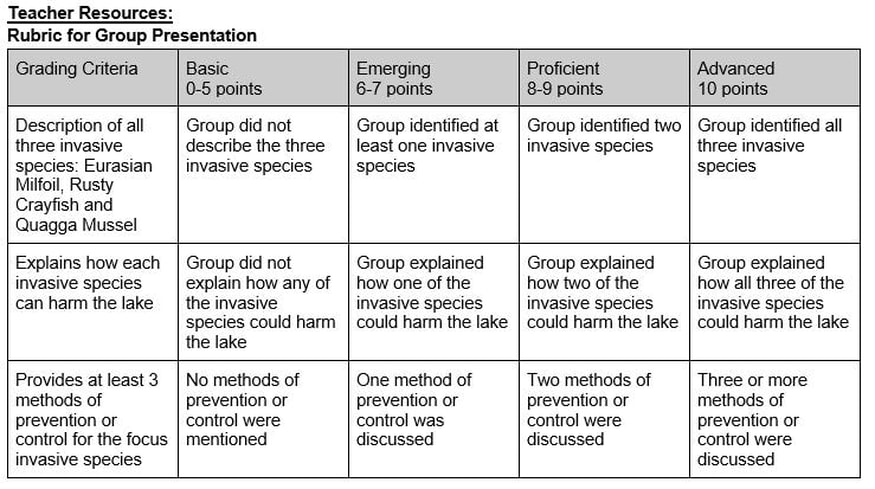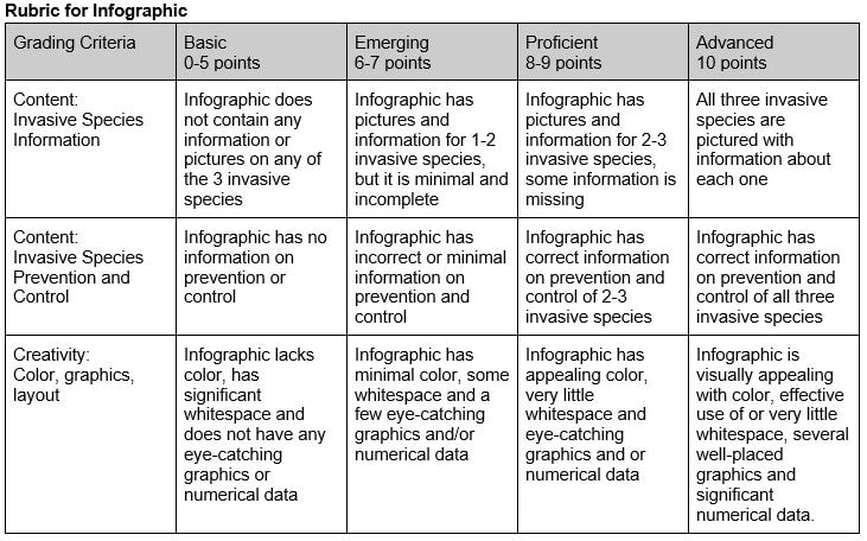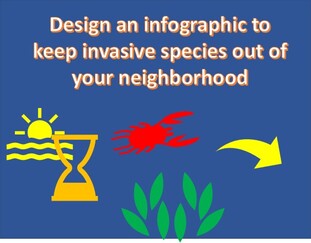
Stop Aquatic Invaders in our Neighborhood
By Erica Sprague, Meridian Junior High Schools
CLICK ON IMAGE TO DOWNLOAD A PRINTABLE VERSION OF THIS LESSON PLAN
We would greatly appreciate your feedback! Click here to complete a short survey telling us about your experience with this lesson plan.
By Erica Sprague, Meridian Junior High Schools
CLICK ON IMAGE TO DOWNLOAD A PRINTABLE VERSION OF THIS LESSON PLAN
We would greatly appreciate your feedback! Click here to complete a short survey telling us about your experience with this lesson plan.
Target Grades: Middle School (6-8). Cross-curricular Science, Social Studies, and ELA
Lesson Overview:
Students will be challenged with helping a local homeowners association on a private lake develop and implement a plan for keeping aquatic invasive species out of their lake when it opens up to public use this spring. The lesson guides students through the challenge of helping people understand what invasive species are and how to identify them, how to create guidelines for keeping them out of the lake and what to do if an invasive species is spotted. This lesson will focus on three different invasive species to look out for.
In other neighborhoods, a similar project could be designed to assist keeping invasive species out of vacant lots or community gardens, based on food webs of terrestrial organisms.
Sources Consulted: ● Arresting the Spread of Eurasian Watermilfoil (Myriophyllum spicatum) in the Great Lakes
Learning Objectives:
After the lesson, students will be able to…
Lesson duration: 2 -3 sixty minute class periods (longer if students do full presentations in class)
Michigan Science Standards Addressed:
SEP: Science and Engineering Practices
Michigan Social Studies and ELA Standards addressed:
Social Studies Process and Skills Standards: Grades 6 - 8
P3 PUBLIC DISCOURSE AND DECISION MAKING
P3.1 Clearly state an issue as a question of public policy, gather and interpret information about that issue, and generate and evaluate possible alternative resolutions.
P3.3 Construct arguments expressing and justifying decisions on public policy issues supported with evidence.
ELA Standards
List of Materials:
Room Arrangement or Special Needs
Students are grouped together for the activities and lab (3-4 students max).
New Vocabulary
Non-Native Species: Species that have been introduced into an ecosystem that they have not historically been a part of (synonyms: alien species, nonindigenous species, introduced species)
Invasive Species: A non-native species in an ecosystem that may cause harm to the economy, the environment or human health.
Food Web: A system of interconnected and interrelated food chains
Infographic: a visual image such as a chart or diagram used to represent information or data
5E Model Lesson Plan
Engage - Guiding Question: How can our local homeowners association work together to stop invasive species from getting into our private lake once it is open to the public? Students are faced helping to solve this problem. A group of homeowners on a private lake want to make sure that their lake stays invader free once it becomes open to the public. They are opening a public boat launch and dock next spring. The association has asked students to present information to the people who currently live on the lake to help them understand invasive aquatic species, why we need to keep them out, how to identify them, etc. Students are also being asked to create infographics for homeowners and people using the public access point.
Explore - Getting to Know the Invaders
Explain - Why Are Invasive Species Bad for the Neighborhood Lake
Investigate Food Webs
Lesson Overview:
Students will be challenged with helping a local homeowners association on a private lake develop and implement a plan for keeping aquatic invasive species out of their lake when it opens up to public use this spring. The lesson guides students through the challenge of helping people understand what invasive species are and how to identify them, how to create guidelines for keeping them out of the lake and what to do if an invasive species is spotted. This lesson will focus on three different invasive species to look out for.
In other neighborhoods, a similar project could be designed to assist keeping invasive species out of vacant lots or community gardens, based on food webs of terrestrial organisms.
Sources Consulted: ● Arresting the Spread of Eurasian Watermilfoil (Myriophyllum spicatum) in the Great Lakes
Learning Objectives:
After the lesson, students will be able to…
- Define invasive species
- Identify 3 common aquatic invasive species and explain how they can harm a lake ecosystem
- Create a presentation and infographic handout for local homeowners who live on the lake to help them understand the effects of aquatic invasive species, how to identify them, how to keep them out of the lake and what to do if they are spotted.
Lesson duration: 2 -3 sixty minute class periods (longer if students do full presentations in class)
Michigan Science Standards Addressed:
SEP: Science and Engineering Practices
- Asking questions and defining problems
- Constructing explanations and designing solutions
- Obtaining, evaluating, and communicating information
- MS-LS2-1 Analyze and interpret data to provide evidence for the effects of resource availability on organisms and populations of organisms in an ecosystem.
- MS-LS2-3 Develop a model to describe the cycling of matter and flow of energy among living and nonliving parts of an ecosystem.
- MS-LS2-4 Construct an argument supported by empirical evidence that changes to physical or biological components of an ecosystem affect populations.
- Cause and Effect
- Stability and Change
Michigan Social Studies and ELA Standards addressed:
Social Studies Process and Skills Standards: Grades 6 - 8
P3 PUBLIC DISCOURSE AND DECISION MAKING
P3.1 Clearly state an issue as a question of public policy, gather and interpret information about that issue, and generate and evaluate possible alternative resolutions.
P3.3 Construct arguments expressing and justifying decisions on public policy issues supported with evidence.
ELA Standards
- Write informative/explanatory texts, including scientific … or technical processes.
- Introduce a topic clearly, previewing what is to follow; organize ideas, concepts, and information into broader categories as appropriate to achieving purpose; include…graphics and multimedia when useful to aiding comprehension.
- Develop the topic with relevant, well-chosen facts, definitions, concrete details, or other information and examples.
List of Materials:
- Computer access to links or printed articles.
- Infographics can be done on construction paper if computers are not available (markers, scissors, glue, etc. may be used)
Room Arrangement or Special Needs
Students are grouped together for the activities and lab (3-4 students max).
New Vocabulary
Non-Native Species: Species that have been introduced into an ecosystem that they have not historically been a part of (synonyms: alien species, nonindigenous species, introduced species)
Invasive Species: A non-native species in an ecosystem that may cause harm to the economy, the environment or human health.
Food Web: A system of interconnected and interrelated food chains
Infographic: a visual image such as a chart or diagram used to represent information or data
5E Model Lesson Plan
Engage - Guiding Question: How can our local homeowners association work together to stop invasive species from getting into our private lake once it is open to the public? Students are faced helping to solve this problem. A group of homeowners on a private lake want to make sure that their lake stays invader free once it becomes open to the public. They are opening a public boat launch and dock next spring. The association has asked students to present information to the people who currently live on the lake to help them understand invasive aquatic species, why we need to keep them out, how to identify them, etc. Students are also being asked to create infographics for homeowners and people using the public access point.
Explore - Getting to Know the Invaders
- Know/Need to Know: Students will read the engage scenario in small groups and make a list about what they know about the project and what they want or need to know before the project starts.
- Fact Files: Be An Expert: Students will read information about the three aquatic invasives being highlighted in this project. They will record their findings from the web using the three sources provided first, then google searches if more information is needed.
- Video Options:
Explain - Why Are Invasive Species Bad for the Neighborhood Lake
Investigate Food Webs
- Watermilfoil: Depending on the academic level of the class, the teacher may assign or adapt the article from Arresting the Spread of Eurasian Watermilfoil (Myriophyllum spicatum) in the Great Lakes as a pre-learning lesson for the food web analysis.
- Have students analyze the two food web situations where milfoil is present (left) and native aquatic plants are present (right).
- What is different in each food web?
- How does the milfoil affect this food web?
- If the homeowners association on our private lake want to host a bass fishing tournament in the future, how could milfoil affect the bass fishing?
- Have students analyze the two food web situations where milfoil is present (left) and native aquatic plants are present (right).

Above image is directly from on-line site: https://mtri.org/assets/eurasian_watermilfoil/impacts_fig7.jpg
2. Zebra Mussels and Quagga Mussels: Have students investigate the diagram showing how biomass is altered in food webs where mussels are present. Photo Credit
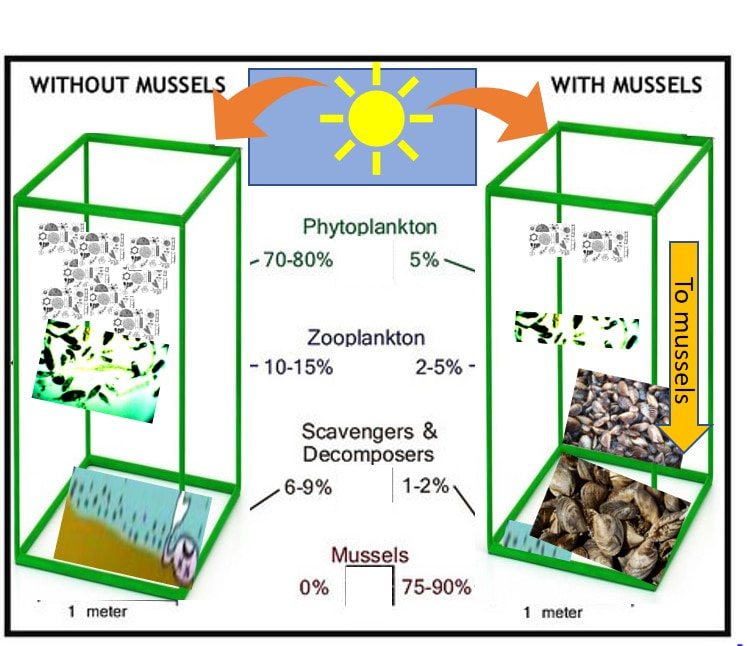
This diagram is based on a drawing by Jennifer Yauck about how the flow of energy has changed in the food web of Lake Michigan due to the presence of quagga mussels. Scientists Russell Cuhel and Carmen Aguilar compared areas with and without mussels. When mussels were present, they filtered algae from the water, depositing it as waste products on the bottom of the lake, and reducing the density of algae and all the organisms in the food web that depended on them.
- What are the mussels eating?
- How does the mussel affect fish?
- Why do you think phytoplankton are affected by the mussels more than scavengers and decomposers?
3. Rusty Crayfish: Look at the food web with native and rusty crayfish.
- What would happen if the rusty crayfish were removed?
- What organism competes with the rusty crayfish?
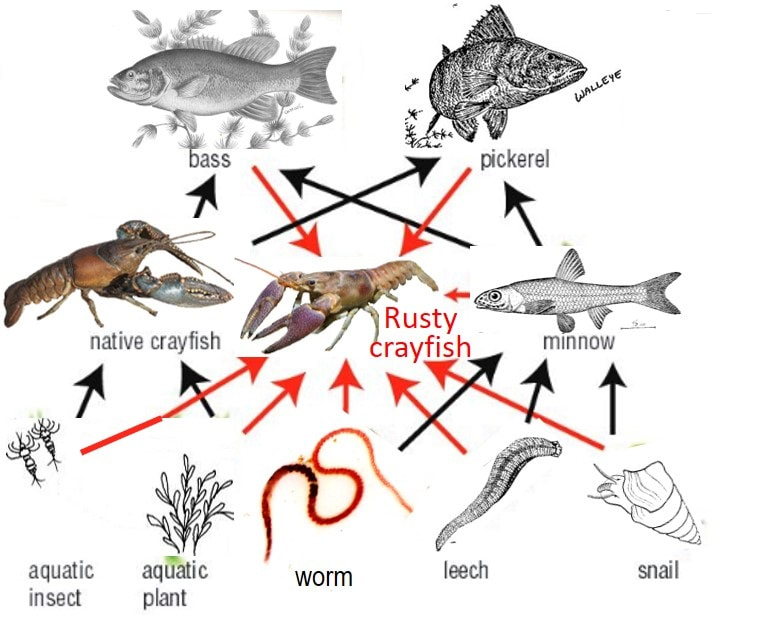
Effects of rusty crayfish on food webs in the Great Lakes region. The rusty crayfish not only feeds on the same foods as native crayfish, it also eats fish egg, such as from bass and pickerel. Large bass and pickerel eat native crayfish but are less likely to attack rusty crayfish. When scientists in Wisconsin removed rusty crayfish from a pond they had invaded, snails, native crayfish, and aquatic plants increased enormously and some fish species increased as well.
Elaborate - Create a Presentation for the Homeowners Association
Evaluate - Create an Infographic for People Using the Lake for Recreation
- As a group, create a presentation using a slideshow or a poster board that accomplishes the following for the homeowners association:
- Identify the three featured invasive species: Quagga Mussel, Eurasian Milfoil, Rusty Crayfish
- Explain how they can harm the lake if they are introduced
- Provide ways to prevent them from getting into the lake and/or control them if they are introduced to the lake
Evaluate - Create an Infographic for People Using the Lake for Recreation
- The Lake Homeowners Association has asked for an infographic handout to be available for all homeowners and those who use the public dock for recreation when it opens next spring. Individual students will create an infographic handout that gives the same information as the presentation that is single sided, catchy and easy to read.
- There are several websites that give good information on creating effective infographics. Here are a few:

New lesson plan ideas are welcome and will be uploaded as they are received and approved.
For submitting lesson plans about invasive species, send inquiry to jeffram(at)gmail.com
For submitting lesson plans about science and science careers, send inquiry to jchadde(at)mtu.edu
The DPSCD lesson plan template should be used for lesson plan submissions by all DPSCD teachers
Lesson plan ideas from other web sites:
From Pennsylvania Sea Grant: 10 lesson plans about interactions of invasive species, biodiversity, and climate change
Creation of the above page of educational resources was funded in part by the Michigan Invasive Species Grant Program through the Departments of Natural Resources, Environmental Quality, and Agricultural and Rural Development.
This material is also based upon work supported by the National Science Foundation under Grant No. 1614187.
Any opinions, findings, and conclusions or recommendations expressed in this material are those of the authors and do not necessarily reflect the views of the National Science Foundation.
For submitting lesson plans about invasive species, send inquiry to jeffram(at)gmail.com
For submitting lesson plans about science and science careers, send inquiry to jchadde(at)mtu.edu
The DPSCD lesson plan template should be used for lesson plan submissions by all DPSCD teachers
Lesson plan ideas from other web sites:
From Pennsylvania Sea Grant: 10 lesson plans about interactions of invasive species, biodiversity, and climate change
Creation of the above page of educational resources was funded in part by the Michigan Invasive Species Grant Program through the Departments of Natural Resources, Environmental Quality, and Agricultural and Rural Development.
This material is also based upon work supported by the National Science Foundation under Grant No. 1614187.
Any opinions, findings, and conclusions or recommendations expressed in this material are those of the authors and do not necessarily reflect the views of the National Science Foundation.
